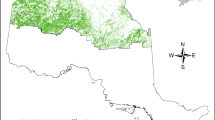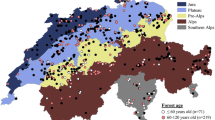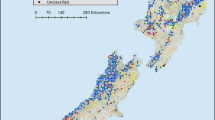Abstract
Land-use changes are one of the major drivers of global change. In many developed countries socioeconomic changes have induced forest expansion during the last centuries, with still seldom explored implications for ecosystem services. We assessed the growth rate and the contribution of these “new forests” on C storage under the imprint of land-use history from Mediterranean to temperate forests in two biogeographical regions in the Iberian Peninsula, using data from 6422 plots of the Spanish National Forest Inventory (1986–2007) and the land-cover map of 1956 to distinguish among pre-existing and new forests (appeared after 1956). Almost a quarter of current forests were new forests and they represented 22% of the total C pool. New forests maintained similar C stocks than pre-existing ones (~45 Mg ha−1), but they are growing at rates 25% faster. Considering the whole Spanish forested territory, the new forest growth rate would offset around 9% of the rate of total C emitted in Spain between 1986 and 2007. The effects of land-use history on forest growth and C stocks varied with environmental conditions (for example, growth of new forests in areas with less water availability was higher than in pre-existing ones), supporting the idea that agricultural legacies may prevail in the long term. In a time when European forests exhibit the first signs of carbon sink saturation, our study endows a relevant ecological role to new forests appearing in the second half of the twentieth century.




Similar content being viewed by others
References
Barberó M, Loisel R, Quézel P, Richardson DM, Romane F. 1998. Pines of the mediterranean basin. In: Richardson DM, Ed. Ecology and biogeography of pinus. Cambridge: Cambridge University Press. p 153–70.
Basnou C, Álvarez E, Bagaria G, Guardiola M, Isern R, Vicente P, Pino J. 2013. Spatial patterns of land use changes across a Mediterranean metropolitan landscape: implications for biodiversity management. Environ Manage 52:971–80.
Basnou C, Vicente P, Espelta JM, Pino J. 2015. Of niche differentiation, dispersal ability and historical legacies: what drives woody community assembly in recent Mediterranean forests? Oikos. doi:10.1111/oik.02534.
Bellassen V, Viovy N, Luyssaert S, Le Maire G, Schelhaas MJ, Ciais P. 2011. Reconstruction and attribution of the carbon sink of European forests between 1950 and 2000. Glob Change Biol 17:3274–92.
Blondel J, Aronson J. 1995. Biodiversity and ecosystem function in the Mediterranean basin: Human and nonhuman determinants. In: Davis GW, Richardson DM, Eds. Mediterranean-type ecosystems: the function of biodiversity. Berlin: Springer-Verlag. p 43–105.
Bonan GB. 2008. Forests and climate change: forcings, feedbacks, and the climate benefits of forests. Science 320:1444–9.
Burnham KP, Anderson DR. 2002. Model selection and multimodel inference: a practical information-theoretic approach. 2nd edn. New York: Springer-Verlag.
Carbon Dioxide Information Analysis Center, U.S. Department of Energy. Spain fossil-fuel CO2 emissions. URL: http://cdiac.ornl.gov/trends/emis/tre_spa.html.
Chazdon RL. 2008. Beyond deforestation: restoring forests and ecosystem services on degraded lands. Science 320:1458–60.
Ciais P, Schelhaas MJ, Zaehle S, Piao SL, Cescatti A, Liski J, Luyssaert S, Le-Maire G, Schulze E-D, Bouriaud O, Freibauer A, Valentini R, Nabuurs GJ. 2008. Carbon accumulation in European forests. Nat Geosci 1:425–9.
Compton JE, Boone RD. 2000. Long-term impacts of agriculture on soil carbon and nitrogen in New England forests. Ecology 81:2314–30.
Cramer VA, Hobbs RJ, Standish RJ. 2008. What’s new about old fields? Land abandonment and ecosystem assembly. Trends Ecol Evol 23:104–12.
Dambrine E, Dupouey JL, Laüt L, Humbert L, Thinon M, Beaufils T, Richard H. 2007. Present forest biodiversity patterns in france related to former roman agriculture. Ecology 88:1430–9.
Erb KH, Kastner T, Luyssaert S, Houghton RA, Kuemmerle T, Olofsson P, Haberl H. 2013. Bias in the attribution of forest carbon sinks. Nat Clim Chang 3:854–6.
Espelta JM, Riba M, Retana J. 1995. Patterns of seedling recruitment in west-mediterranean Quercus ilex forests influenced by canopy development. J Veg Sci 6:465–72.
Falcucci A, Maiorano L, Boitani L. 2007. Changes in land-use/land-cover patterns in Italy and their implications for biodiversity conservation. Landsc Ecol 22:617–31.
Fernández-Martínez M, Vicca S, Janssens IA, Sardans J, Luyssaert S, Campioli M, Chapin FSIII, Ciais P, Malhi Y, Obersteiner M, Papale D, Piao SL, Reichstein M, Roda F, Peñuelas J. 2014. Nutrient availability as the key regulator of global forest carbon balance. Nat Clim Chang 4:471–6.
Flinn KM, Marks PL. 2007. Agricultural legacies in forest environments: tree communities, soil properties, and light availability. Ecol Appl 17:452–63.
Forest Europe. 2015. State of Europe’s forests 2015. In: Ministerial conference on the protection of forests in Europe.
Foster D, Swanson F, Aber J, Burke I, Brokaw N, Tilman D, Knapp A. 2003. The importance of land-use legacies to ecology and conservation. Bioscience 53:77–88.
Fuchs R, Herold M, Verburg PH, Clevers JGPW. 2013. A high-resolution and harmonized model approach for reconstructing and analysing historic land changes in Europe. Biogeosciences 10:1543–59.
Gracia C, Burriel JA, Ibáñez JJ, Mata T, Vayreda J. 2004a. Inventari Ecològic i Forestal de Catalunya. Mètodes, Vol. 9. Bellaterra: CREAF.
Gracia C, Burriel JA, Ibáñez JJ, Mata T, Vayreda J (2004b) Inventari Ecològic i Forestal de Catalunya. Mètodes, Vol. 10. Bellaterra: CREAF.
Gerstner K, Dormann CF, Stein A, Manceur AM, Seppelt R. 2014. Effects of land use on plant diversity—a global meta-analysis. J Appl Ecol 51:1690–700.
Grove AT, Rackham O. 2001. The nature of Mediterranean Europe: an ecological history. New Haven: Yale University Press.
Hargreaves GH, Samani ZA. 1982. Estimating potential evapotranspiration. J Irrig Drain Eng 108:225–30.
Hooker TD, Compton JE. 2003. Forest ecosystem carbon and nitrogen accumulation during the first century after agricultural abandonment. Ecol Appl 13:299–313.
Houghton RA, Hackler JL, Lawrence KT. 1999. The U.S. carbon budget: contributions from land-use change. Science 285:574–8.
Iriarte-Goñi I. 2013. Forests, fuelwood, pulpwood and lumber in Spain, 1860–2000: a non-declensionist story. Environ Hist 18:333–59.
Kauppi PE, Ausubel JH, Fang J, Mather AS, Sedjo RA, Waggoner PE. 2006. Returning forests analyzed with the forest identity. PNAS 103:17574–579.
Kuemmerle T, Kaplan JO, Prishchepov AV, Rylskyy I, Chaskovskyy O, Tikunov VS, Müller D. 2015. Forest transitions in Eastern Europe and their effects on carbon budgets. Global Chang Biol 21:3049–61.
Laurance WF. 1999. Reflections on the tropical deforestation crisis. Biol Conserv 91:109–17.
Leuschner C, Wulf M, Baüchler P, Hertel D. 2014. Forest continuity as a key determinant of soil carbon and nutrient storage in beech forests on sandy soils in northern Germany. Ecosystems 17:497–511.
Luyssaert S, Schultze E-D, Börner A, Knohl A, Hessenmöller D, Law BE, Ciais P, Grace J. 2008. Old-growth forests as global carbon sinks. Nature 455:213–15.
Malhi Y, Roberts T, Betts RA, Killeem TJ, Li W, Nobre CA. 2008. Climate change, deforestation, and the fate of the Amazon. Science 319:169–72.
Mather A. 1990. Global forest resources. London: Bellhaven Press.
Meyfroidt P, Lambin EF. 2011. Global forest transition: prospects for an end to deforestation. Annu Rev Environ Resour 36:343–71.
Millennium Ecosystem Assessment. 2005. Ecosystems and human well-being: biodiversity synthesis. Washington, DC: World Resources Institute.
Nabuurs GJ, Schelhaas MJ, Mohren GMJ, Field CB. 2003. Temporal evolution of the European forest sector carbon sink from 1950 to 1999. Glob Change Biol 9:152–60.
Nabuurs GJ, Lindner M, Verkerk PJ, Gunia K, Deda P, Michalak R, Grassi G. 2013. First signs of carbon sink saturation in European forest biomass. Nat Clim Chang 3:792–6.
Navarro LM, Pereira HM. 2012. Rewilding abandoned landscapes in Europe. Ecosystems 15:900–12.
Ninyerola M, Pons X, Roure JM. 2005. Atlas Climático Digital de la Península Ibérica. Metodología y aplicaciones en bioclimatología y geobotánica. Bellaterra: Universidad Autónoma de Barcelona.
Pan Y, Birdsey RA, Fang J, Houghton R, Kauppi PE, Kurz WA, Phillips OL, Shvidenko A, Lewis SL, Canadell JG, Ciais P, Jackson RB, Pacala SW, McGuire AD, Piao S, Rautiainen A, Sitch S, Hayes D. 2011. A large and persistent carbon sink in the world’s forests. Science 333:988–93.
R Development Core Team. 2014. R: a language and environment for statistical computing. Vienna: R Foundation for Statistical Computing. URL: www.r-project.org/.
Rodrigo A, Retana J, Picó X. 2004. Direct regeneration is not the only response of Mediterranean forests to large fires. Ecology 85:716–29.
Rudel TK, Coomes OT, Moran E, Achard F, Angelsen A, Xu J, Lambin E. 2005. Forest transitions: towards a global understanding of land use change. Glob Environ Change 15:23–31.
Ruiz-Benito P, Gómez-Aparicio L, Paquette A, Messier C, Kattge J, Zavala MA. 2014. Diversity increases carbon storage and tree productivity in Spanish forests. Glob Ecol Biogeogr 23:311–22.
Schroter D, Cramer W, Leemans R, Prentice IC, Araujo MB, Arnell NW, Bondeau A, Bugmann H, Carter TR, Gracia CA, Anne C. 2005. Ecosystem service supply and vulnerability to global change in Europe. Science 310:1333–7.
Sheffer E. 2012. A review of the development of Mediterranean pine-oak ecosystems after land abandonment and afforestation: are they novel ecosystems? Ann For Sci 69:429–43.
Spanish Ministry of Agriculture, Food and Environment. URL http://www.magrama.gob.es/en/.
Tang J, Luyssaert S, Richardson AD, Kutsch W, Janssens IA. 2014. Steeper declines in forest photosynthesis than respiration explain age-driven decreases in forest growth. PNAS 111:8856–860.
Terradas J. 1999. Holm oak and holm oak forests: an introduction. In: Rodà F, Retana J, Gracia C, Bellot J, Eds. Ecology of mediterranean evergreen oak forests, ecological studies, Vol. 137. Berlin: Springer-Verlag. p 3–14.
Turner BLII, Lambin EF, Reenberg A. 2007. The emergence of land change science for global environmental change and sustainability. Proc Natl Acad Sci USA 104:20666–71.
Vallejo R, Aronson J, Pausas JC, Cortina J. 2005. Restoration of mediterranean woodlands. In: van Andel J, Aronson J, Eds. Restoration ecology: a European perspective. Oxford: Blackwell Science. p 193–207.
Vayreda J, Martínez-Vilalta J, Gracia M, Retana J. 2012. Recent climate changes interact with stand structure and management to determine changes in tree carbon stocks in Spanish forests. Glob Change Biol 18:1028–41.
Vicca S, Luissaert S, Pañuelas J, Campioli M, Chapin FSIII, Ciais P, Heinemeyer A, Högberg P, Kutsch WL, Law BE, Malhi Y, Papale D, Piao SL, Reichstein M, Schulze ED, Janssens IA. 2012. Fertile forests produce biomass more efficiently. Ecol Lett 15:520–6.
Vilà M, Vayreda J, Comas LL, Ibáñez JJ, Mata T, Obón B. 2007. Species richness and wood production: a positive association in Mediterranean forests. Ecol Lett 10:241–50.
Villaescusa R, Díaz R, Eds. 1998. Segundo Inventario Forestal Nacional (1986–1996). Madrid: Ed. Ministerio de Medio Ambiente.
Villanueva JA, Ed. 2005. Tercer Inventario Forestal Nacional (1997–2007). Madrid: Ed. Ministerio de Medio Ambiente.
von Oheimb G, Härdtle W, Eckstein D, Engelke HH, Hehnke T, Wagner B, Fichtner A. 2014. Does forest continuity enhance the resilience of trees to environmental change? PLoS ONE. doi:10.1371/journal.pone.0113507.
Zavala MA, Espelta JM, Retana J. 2000. Constraints and trade-offs in mediterranean plant communities: the case of holm oak-Aleppo pine forests. Bot Rev 66:119–49.
Acknowledgements
Financial support for this study was obtained from the Spanish Ministry of Economy and Competitiveness via competitive Grant CGL2012-33398 (NOVFORESTS Project) and the 2014SGR-0913 from the autonomous government of Catalonia.
Author information
Authors and Affiliations
Corresponding author
Additional information
Author contributions
AVC, JME, JV and JP conceived the study; AVC, JME and JP performed the research; AVC analyzed data; AVC, JME, JV and JP wrote the paper.
Electronic supplementary material
Below is the link to the electronic supplementary material.
Rights and permissions
About this article
Cite this article
Vilà-Cabrera, A., Espelta, J.M., Vayreda, J. et al. “New Forests” from the Twentieth Century are a Relevant Contribution for C Storage in the Iberian Peninsula. Ecosystems 20, 130–143 (2017). https://doi.org/10.1007/s10021-016-0019-6
Received:
Accepted:
Published:
Issue Date:
DOI: https://doi.org/10.1007/s10021-016-0019-6




